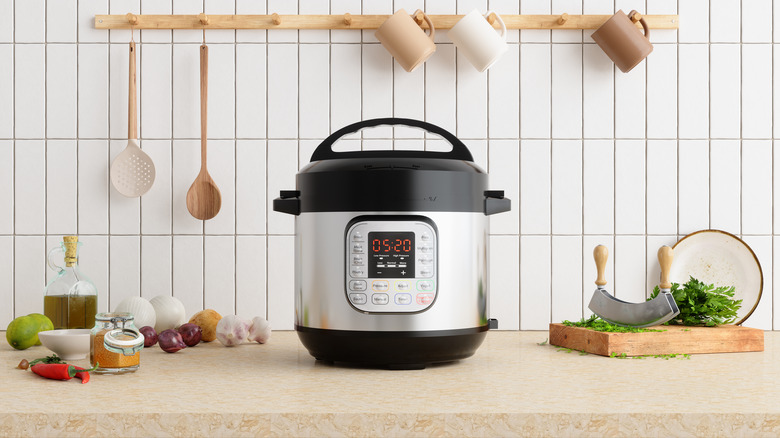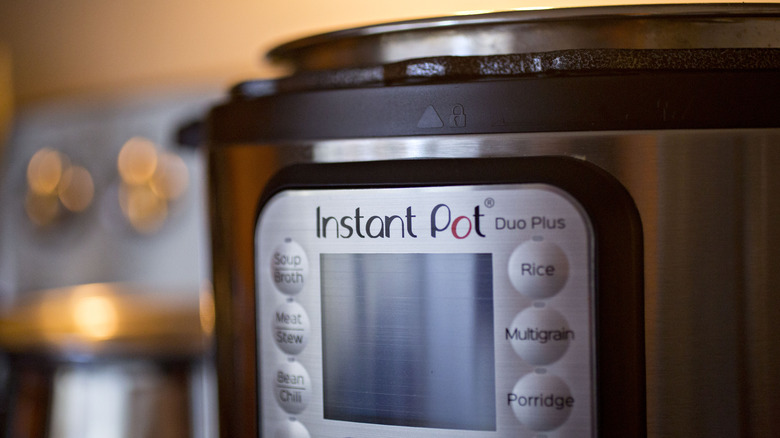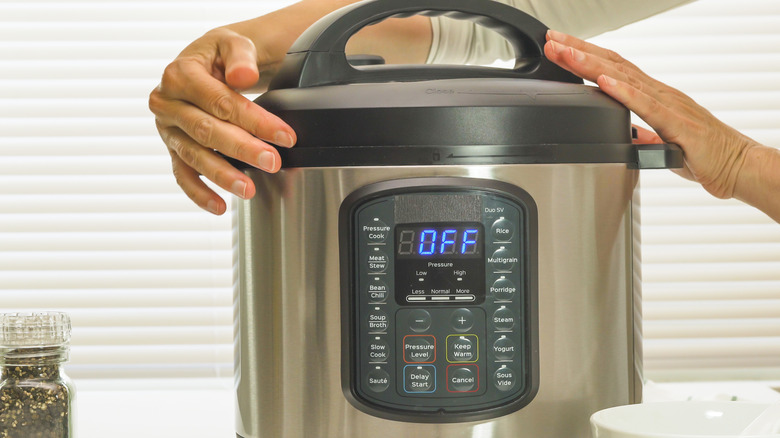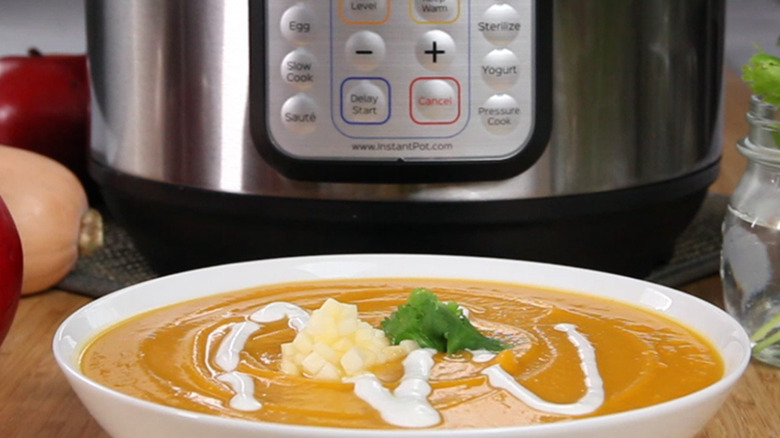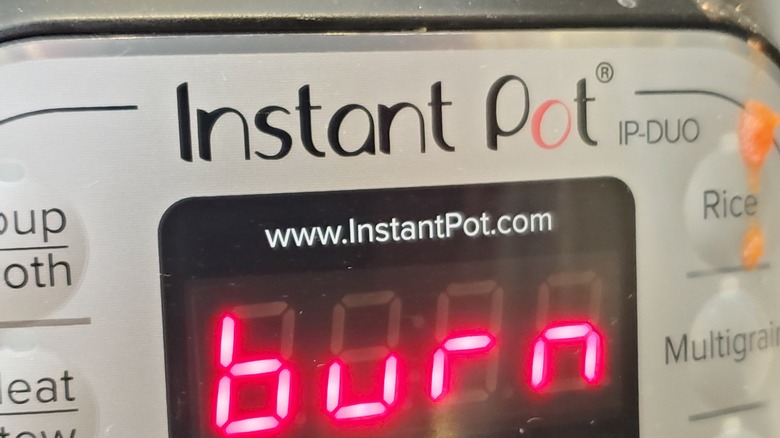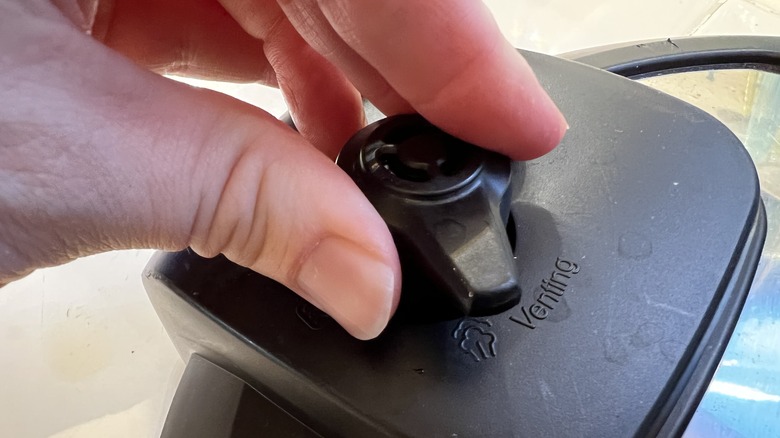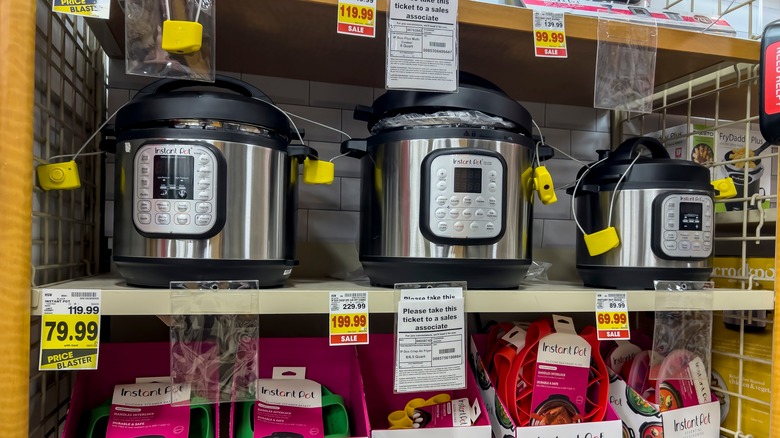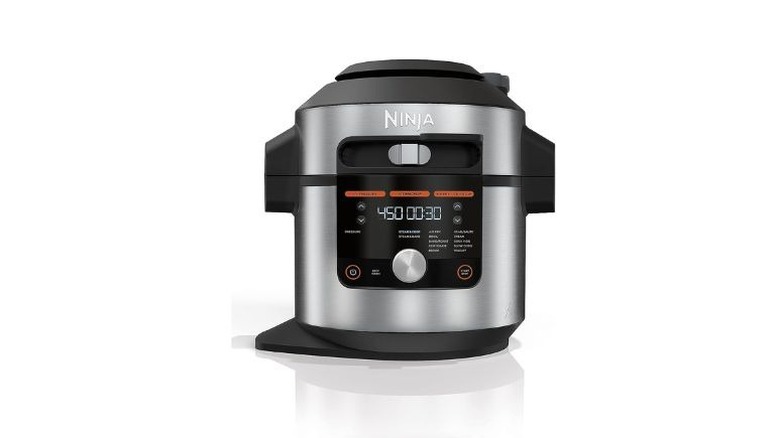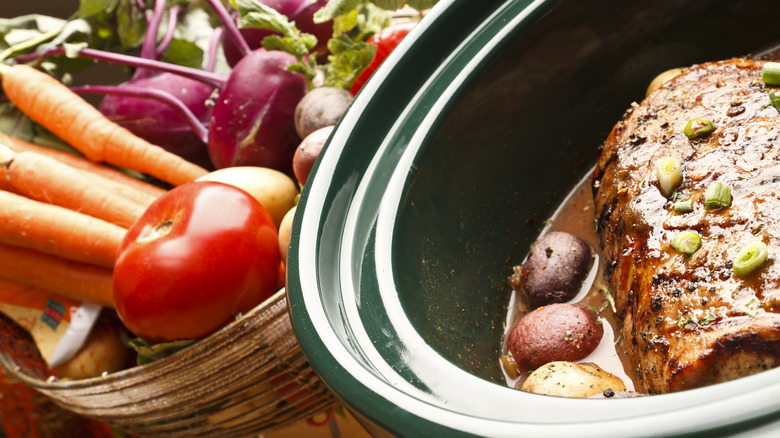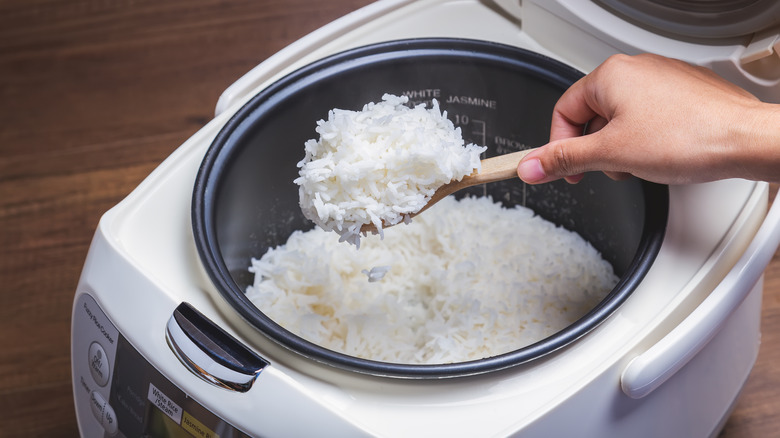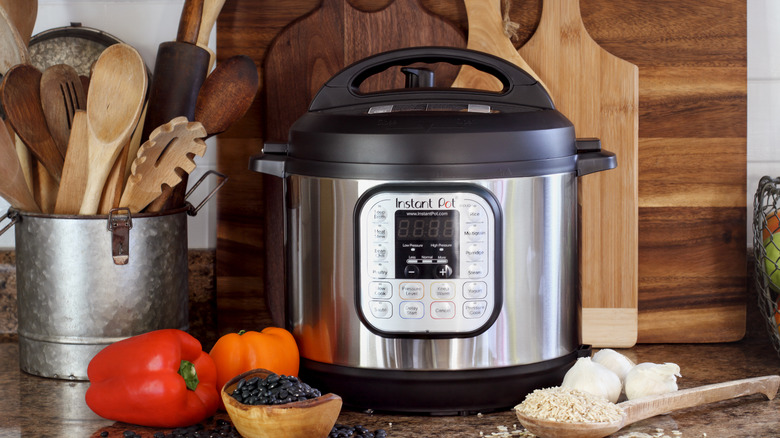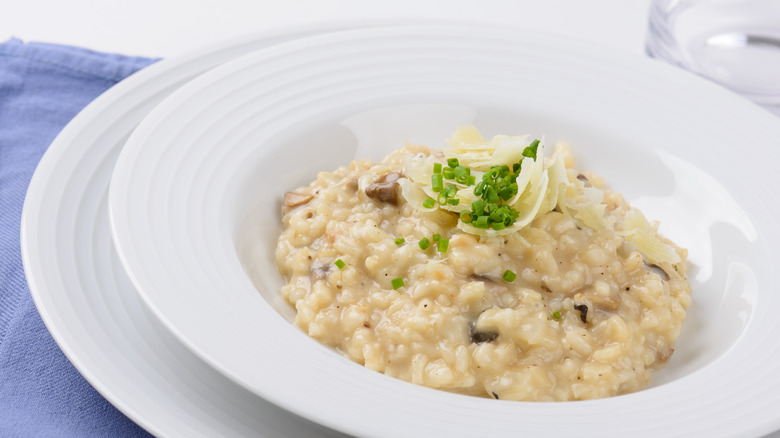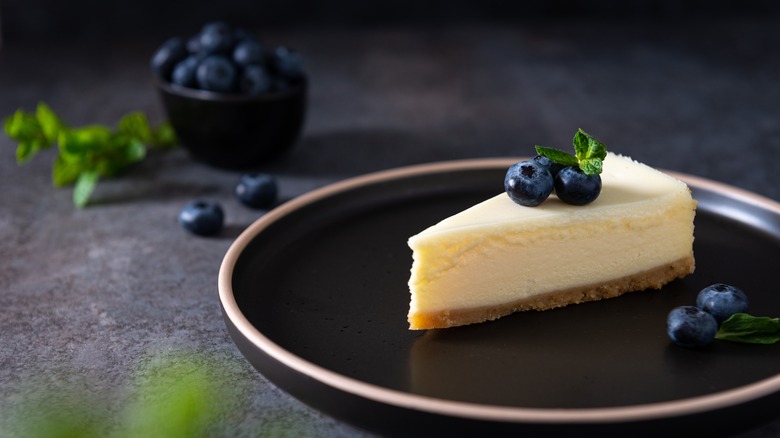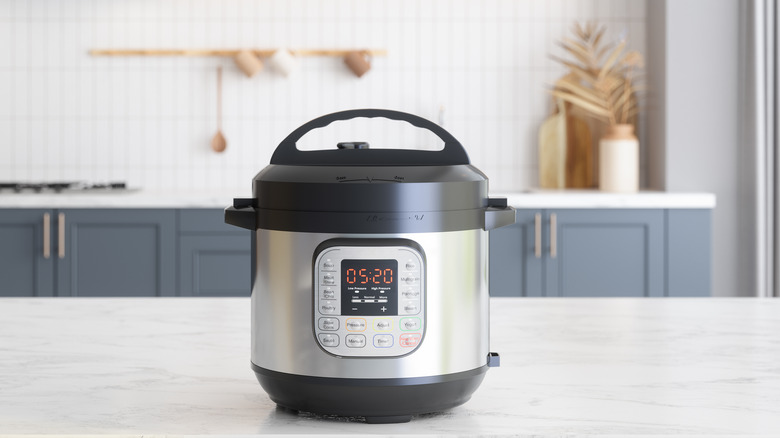What Is An Instant Pot And How To Use It
We may receive a commission on purchases made from links.
It's been over a decade since Instant Pot hit the American market and became a runaway hit. And while these products aren't in the spotlight quite as much as they once were, those who discovered Instant Pots during the height of their popularity are still using them regularly to make kitchen prep faster and more convenient.
The founder of Instant Brands, Dr. Robert Wang, set out to make kitchen products that would help busy families prepare food quickly and easily, so they can eat healthily and decrease their consumption of fast food. Using an advanced microprocessor, Instant Pots were designed to serve as five appliances in one: pressure cooker, slow cooker, rice cooker, steamer, and warmer. Even celebrity cooks have become fans of this multicooker: Carla Hall has said she loves cooking with an Instant Pot, especially for making quick dinners or prepping a big holiday meal.
The company was acquired by a private equity firm in 2019 and merged with Pyrex and CorningWare, keeping the Instant Brands name. Just recently, Instant Brands filed for bankruptcy. But hopefully, the restructuring will help the company resolve its financial woes so it can continue to make innovative kitchen appliances for years to come. In the meantime, whether you've used an Instant Pot before or you're just discovering it, learning everything you can about how to use an Instant Pot will enable you to get the most out of your appliance.
What is an Instant Pot?
An Instant Pot is an electric countertop appliance that has multiple functions — the generic term for this appliance is multicooker. It works as a pressure cooker, slow cooker, rice cooker, steamer, and sauté pan. Some models have even more functions; you can use your Instant Pot to try cooking sous vide, make your own homemade yogurt, or bake a cake.
Instant Pots have a removable stainless steel inner pot that holds the food, and a locking lid with a gasket and a steam vent that allow the pot to safely come up to temperature under pressure. A control panel enables the user to choose their cooking mode, adjust temperatures and pressure levels, and select the cooking time.
You can figure out how to cook anything in an Instant Pot by adjusting the amount of liquid in a recipe and reducing the cooking time. Like any pressure cooker, Instant Pots require a certain amount of cooking liquid since the steam from the evaporating liquid is what builds the pressure inside the vessel.
How do you use an Instant Pot?
Garage sales and online swap groups are littered with Instant Pots that were bought on a whim and never used... in many cases, because the users didn't take the time to learn how to use them, or because they got frustrated by common mistakes that everyone makes with their Instant Pot. Armed with the instruction manual and a bit of patience, learning how to use an Instant Pot is easy and rewarding.
To use the pressure cooker of an Instant Pot, put the ingredients in the stainless steel insert. Make sure you have at least 1½ cups of a water-based liquid for a 6-quart pot (or 2 cups for the 8-quart version) and the pot should not be more than ⅔ full. Put the lid on, make sure the steam release valve is closed, and program the pressure level and cooking time according to the recipe. When the timer goes off, you can either quick-release the pressure or let the cooker set for the pressure to release naturally before opening the pot and enjoying your hot meal. The other functions, such as slow cooker or sauté, are even easier and more straightforward.
There are plenty of tips you can use when cooking with an Instant Pot, from knowing when to quick-release the pressure to knowing what to do when the dreaded "burn" error message shows up. With practice, you'll master using your Instant Pot.
What to cook in an Instant Pot
In the many Instant Pot community groups that have popped up on Facebook and other social media platforms, you'll see people cooking everything from pasta to cakes in their Instant Pots. There are certain types of foods that are ideal for pressure cooking. The best foods to cook in an Instant Pot are those that are liquid-based, such as soups, stews, and braises, as well as those that require a long and steady simmering time such as beans and rice.
The absolute best uses for your Instant Pot might come as a surprise. In addition to making stews and broths, you can use your Instant Pot to make homemade yogurt, pop popcorn, make homemade wine or cider, or proof dough.
The Instant Pot can make dishes that are simple to make on the stove even easier. We love the one-pot Instant Pot version of supermodel Gigi Hadid's creamy, spicy pasta. Pasta is cooked in water with olive oil, garlic, green onion, and tomato paste, then the Instant Pot is opened and a sauce is made in the remaining cooking liquid with the addition of cream, Parmesan cheese, and basil.
Are Instant Pots safe to use?
We've all heard tales of exploding pressure cookers spewing their contents or scalding users with hot steam. However, when used correctly, Instant Pots are very safe. The company says the appliance has 10 different mechanisms in place to ensure that it can be used safely, including automatic pressure control, detectors that will prevent the machine from pressurizing if the lid isn't closed properly or the sealing ring isn't in place, and fuses that cut off power if the internal temperature or the electrical current exceeds safe levels. The lid is designed to lock when pressure begins building inside the unit, and it will not unlock until the pressure has been manually or naturally released completely and the float valve has dropped.
However, you can still get hurt by your Instant Pot if you're not careful. The interior of a pressure cooker reaches temperatures of around 250 degrees Fahrenheit, so the steam that releases from the valve and when the lid is removed is extremely hot. Make sure to vent the pressure cooker away from you, and when you remove the lid, tip it in the opposite direction so it shields you from the escaping steam.
You should do the water test before using your Instant Pot for the first time. Instructions for this practice run are in the user manual and it's the best way to familiarize you with your appliance so you can use it safely when it's time to prepare a meal.
How to release pressure on an Instant Pot
Instant Pot pressure cooker recipes will either call for a quick release or a natural release of pressure. Once you've seen a few Instant Pot recipes, you'll get a sense of when to use the quick-release method and when to use the natural-release method. But in general, the quick-release method is used for most types of food, especially those that can easily get overcooked, such as lean proteins and vegetables, and will avoid the risk of overcooking. To quickly release pressure, turn the pressure release handle towards the "venting" position, making sure to avoid the stream of steam that will release until the pot is completely depressurized. This typically takes a couple of minutes.
You should use the natural release method for certain types of foods, such as those that foam when they cook like beans, potatoes, or grains; or tough cuts of meat that require a gentle cooking method. To use this method, when the cooking timer ends, let the Instant Pot sit untouched until the pot cools enough for the pot to depressurize on its own. This process can up to 30 minutes, depending on the contents of the Instant Pot. Some recipes call for a natural release for a certain amount of time, after which you can turn the pressure release handle to finish depressurizing the pot. Whichever method you use, you'll know the pressure is completely released when the lid unlocks.
Different types of Instant Pots
There are currently several different models in the Instant Pot lineup, each of them with a different assortment of functions. By comparing the features of each, you can decide which is the best Instant Pot for your needs. Many of the models come in 6 and 8-quart sizes, while the Duo also comes in a 3-quart size.
Here's the lineup: The Duo is the company's original, flagship model. It has seven functions: rice cooker, slow cooker, yogurt maker, steamer, sauté pan, and food warmer. It also has 13 one-touch programs for various dishes, such as soup, chili, poultry, and porridge. The Duo Plus has the same functions as the Duo, as well as cake and sous vide, and 25 programs. The Pro adds sous vide, sterilizer, and cake baker to the functions and has 28 program settings and five programmable favorite settings. The Pro Plus has smart capabilities, so you can operate it wirelessly through an app, choosing from hundreds of recipes or even commanding it wirelessly to release steam. The Pro Crisp comes with two lids so the appliance can be used for dry-heat methods like air frying, roasting, and broiling. The Duo Crisp has a specially designed lid that enables the appliance to be used for both its pressure-cooker functions as well as for dry-heat cooking methods. The Rio Wide Plus has similar functions to the Duo Plus, with a large cooking surface equivalent to a 12-inch skillet for sautéing and searing.
Other multicooker brands
Although the Instant Pot brand pioneered the multi-cooker category, many other appliance companies have jumped on the bandwagon with their own versions. You can find multi-cookers from well-known brands as well as inexpensive imports.
Here are a few to consider: The Cuisinart High-Pressure Multicooker has 12 preprogrammed settings and functions as a pressure cooker, slow cooker, steamer, or sauté pan. It has a 6-quart capacity. Hamilton Beach makes two pressure cooker multi-cookers. The 8-quart QuickCook Pressure Cooker also has a classic slow cooker feature with three temperature settings and presets for cooking a variety of foods. The 6-quart Precision Pressure Cooker has slow cooker functionality and comes with a temperature probe to monitor the internal temperature of large pieces of meat. It also has a cleaning cycle. The company also makes an air fryer lid that can turn pressure cookers into an air fryer. Ninja makes several multicookers, although only one has a pressure cooker function. The Ninja Foodi 14-in-1 pressure cooker is one of the best pressure cookers and can serve many functions, including steaming and air frying, under a single lid. It also has settings for proofing dough, sous vide, dehydrating, and yogurt.
Instant Pot vs. Crock Pot
While they are both countertop cooking appliances, there are some big differences between an Instant Pot and a Crockpot. Like the Instant Pot, a Crockpot is a brand name for an appliance; namely, a slow cooker. The terms Crockpot and slow cooker are often used interchangeably, but there's a difference between Crockpots and slow cookers: Every Crockpot is a slow cooker, but every slow cooker is not a Crockpot.
Similarly, every Instant Pot has a slow cooker feature, but Crockpots and other slow cookers do not have the pressure cooker feature and other capabilities that Instant Pots have... with one exception. Crockpot makes a multi-cooker that has a pressure cooker feature as well as functions to sterilize, slow cook, saute, sear, boil or simmer, and steam.
If you have an Instant Pot, chances are you can get rid of your Crockpot and use the Instant Pot for slow-cooking recipes. Slow cookers and Instant Pots both excel at making certain types of foods, such as liquid-heavy soups, braises, chili, and beans. However, a Crockpot cooks that food at a steady, gentle temperature of 170 to 280 degrees Fahrenheit depending on the cooker and the setting. This cooks food at a low and low rate to yield tender results. While an Instant Pot can cook food up to 70% faster than on the stove, a Crock Pot slows that cooking time way down, to three hours or more.
Instant Pot vs a pressure cooker
While Instant Pots have only been on the market since 2010, pressure cookers have been around for hundreds of years, and we have a circa-1600s French physicist to thank for the pressure cooker. All pressure cookers work similarly, heating liquid in a sealed pot until it becomes steam, which builds pressure as it heats, increasing the interior temperature beyond the boiling point temperature of 212 degrees Fahrenheit.
This heated, pressurized environment cooks food more quickly than in a traditional pan on a stove. Some pressure cookers are stovetop models, using a burner to heat the pot, and some are electric. While an Instant Pot can do just about anything a pressure cooker can do, Instant Pots have more features that make it more versatile than a dedicated pressure cooker. However, the same tips for cooking with a pressure cooker can apply while using your Instant Pot.
Instant Pot vs. rice cooker
Rice cookers might be considered the original multi-cooker. While early rice cookers were simply electric cookers with one setting that would steam white rice to the perfect consistency, automatic rice cookers are a more recent invention. Advanced rice cookers use "fuzzy logic," a computer chip that makes adjustments to cooking time and temperature to account for differences in water and rice quantities, making perfect rice every time. Like pressure cookers, many rice cookers also have settings for a variety of foods, whether it's brown rice, porridge, grains, or even tofu. With the right tips for using a rice cooker, it can be a remarkable versatile appliance.
Instant Pots make great rice, too, but they use the pressure cooker setting to do it quickly. A typical white rice recipe might only take three minutes of cooking time at high pressure, compared to 20 to 30 minutes in a rice cooker. With its ability to quickly make perfect rice, an Instant Pot can also replace your rice cooker.
What can't Instant Pots do?
One might think that Instant Pots can cook just about anything. But keep in mind, just because you can cook certain things in the Instant Pot, doesn't mean you should cook them in it if there are other cooking methods that are just as easy and don't take much more time, or that will yield a better result. Some Instant Pots have a cake setting, but baked goods in the Instant Pot often turn out dense, so if you prefer a cake that's light and fluffy, you're better off using the oven.
Instant Pots aren't the best cooking method for cooking seafood, because it's delicate and easy to overcook. Creamy, dairy-based foods are also tricky to cook in an Instant Pot because the milk or cream can curdle. So if you like cheesy pasta, know that the best moment to add cheese to Instant Pot pasta is at the end, after the pasta has cooked under pressure.
While it might be tempting to use an Instant Pot's pressure cooker feature as a pressure canner for preserved foods, it's not safe to do so, because of temperature fluctuations. Another thing you shouldn't use your Instant Pot for is deep frying. Even with the sauté setting, the oil will not get hot enough to reach the recommended deep-frying temperature.
Savory Instant Pot recipes
There are hundreds, if not thousands, of tasty Instant Pot recipes out there. Whether you're checking your favorite food blogs and websites or buying cookbooks specifically devoted to Instant Pots or electric pressure cookers, you're bound to find a host of recipes that will help you make delicious meals in your Instant Pot.
Beans are one of the best things to cook in the Instant Pot. They cook in a fraction of the time it takes to cook on the stove, you don't need to soak them overnight, and they'll turn out toothsome and uniformly cooked. Another great use for the Instant Pot is making risotto. Traditionally, this dish is labor-intensive, requiring constant stirring and frequent additions of broth. In the Instant Pot, all the work is done for you, and the result will be just as creamy as risotto made on the stove.
Finally, the pressure cooker setting of the Instant Pot is excellent for cooking tough cuts of meat, such as chuck and round cuts. The pressure cooker does a great job breaking down the tough connective tissues to make juicy, fork-tender meat.
Sweet Instant Pot recipes
There are plenty of fantastic Instant Pot dessert recipes out there, too. When choosing a dessert to make in the Instant Pot, consider one that's moist and dense, as that's the type of dessert that does well in the moist and steamy cooking environment. One of the best desserts to make in the Instant Pot is cheesecake. Cooked using either the pressure cooker or slow cooker function, cheesecake comes out moist and creamy. Other good recipes to try in the Instant Pot are puddings, custards, and dense cakes like flourless chocolate cake or bundt cake.
It's also a great vessel for sweet breakfast and side dishes. Use an Instant Pot to make French toast casserole, sweet potato casserole, or an easy Instant Pot oatmeal. Don't forget the Instant Pot's slow cooker setting, which can also make delicious desserts, including apple cobbler, poached fruit, or rice pudding.
How to clean an Instant Pot
An Instant Pot is fairly easy to clean. The stainless steel pot insert comes out and is dishwasher safe, or can easily be scrubbed by hand. A scouring pad or abrasive cleanser can be used if there are any stuck-on foods. The exterior and display panel can be wiped clean with a damp cloth and some all-purpose cleaning spray.
The lid of the Instant Pot is also dishwasher safe, but there's something you should do before putting the Instant Pot lid in the dishwasher: You should disassemble all the components and hand-wash them so they don't get lost in the dishwasher.
A common complaint about the Instant Pot is that the rubber sealing ring absorbs strong odors such as onions and curry. But many have discovered a steamed lemon trick that gets smells out of an Instant Pot: Combining lemon rinds with a little vinegar and water and running the steam setting for a few minutes will deodorize the interior of the Instant Pot.
